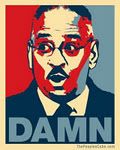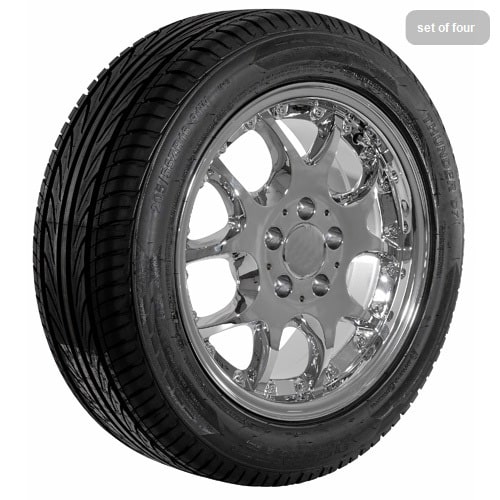Page 1 2
Go  | New  | Find  | Notify  | Tools  | Reply  |  |
posting without pants |
While looking at new cars (for the record, small SUV type in the class of a Nissan Rogue, Honda HRV or similar) I am seeing various options for wheel sizes between 16" and 19" Other than cosmetics, why would a person want wheels, and therefore, tires, of any of the sizes listed? Why bigger, and why smaller? What are the pros and cons? Thanks in advance. Strive to live your life so when you wake up in the morning and your feet hit the floor, the devil says "Oh crap, he's up." | ||
|
| Member |
I don't know what the current thinking is, but a 16" is going to ride better than a 19" (assuming the same overall diameter, smaller tire wall on the 19" rim), and cost less to replace. A 19" rim would allow bigger brakes, but if you're talking about an optional larger size rim on the same vehicle, I doubt that would be the case. If different vehicles, check if the one with bigger wheels also has bigger discs, which of course theoretically makes for better stopping. Personally, I don't like the looks of 19" rims and skinny rubber, but others like them. -------------------------- Every normal man must be tempted, at times, to spit on his hands, hoist the black flag, and begin slitting throats. -- H L Mencken I always prefer reality when I can figure out what it is. -- JALLEN 10/18/18 | |||
|
| Oh stewardess, I speak jive.  |
Comfort/lower price vs Performance/higher price, basically. | |||
|
posting without pants |
Which is which? Strive to live your life so when you wake up in the morning and your feet hit the floor, the devil says "Oh crap, he's up." | |||
|
| Oh stewardess, I speak jive.  |
Sorry. Bigger tires = More air, more cushion, more comfort + Smaller wheels = less expensive. And, generally, it just gets less comfortable and more expensive from there, with some performance gains as the trade off. These are broad statements, and there are exceptions, but that's the gist. Exceptions to the comfort notion happen when bigger tires have super hard side walls. Exceptions to performance exist in case of the balloon-y rear wheels on top fuel dragsters. But primarily big wheels and low profile tires are for looks or performance at a higher price, and little wheels with big tires are cheaper and more comfortable but perform worse. | |||
|
| His diet consists of black coffee, and sarcasm.  |
No matter what the wheel diameter, there is only so much wheel/tire that can fit within the wheel wells without jacking the car up and looking ridiculous. A 19-inch will have shorter sidewalls (from bead to tread) than a 16. Typical 19-inch:  Typical 16-inch:  A short sidewall must, of necessity, be very stiff. This can be a benefit for handling and cornering as there is less flex, but only very discerning drivers will notice this. The short sidewall is critical about air pressure. All tires are, of course, but the stiff sidewall can still look OK while having dangerously low pressure. They leave the wheel vulnerable to damage from potholes and other hazards. Because 19s are getting into "performance tire" (better handling/cornering at the expense of tread life) territory, they are more expensive to replace. They are difficult to mount, but you won't be doing that. Because of the way car options are "packaged," the 19s may be your only choice if you want certain other options. You'll have to decide for yourself which of these factors are more important to you, but 19s would not be my personal choice. | |||
|
| Eating elephants one bite at a time  |
The wierd numbers on tires: P = pmetric (most confuse this to mean passenger). They will have fewer plys (layers) than LT. Usually has mileage warranty. LT = light truck (most assume this to be ALL trucks). These will have more plys than pmetrics. So, a bit more durable. Will require MORE air to operate safely (most inflate like pmetrics and run the chance of separation). Will require more air to handle the same load as pmetrics. Typically 55psi or more. Often times, no mileage warranty. The numbers, unless looking at "flotation" tires (no 1st hand knowledge). You will see 2 numbers for example 265/75 R16. That tire is 265 mm wide with a sidewall that is 75% of the width and a 16" wheel (rim). All that together: P265/75 R16 or LT265/75 R16 Then you can start down the roaf of changing tire sizes or wheel sizes. If you stay close to the original circumference of the original tires, your speedometer should be fine. Too much one way or the other could impact the speedometer causing it to be fast or slow. Find a good tire size calculator (I like the one that a miaya forum had. It showas multiple view angles) to help with choices. If driving through a lot of snow/slush, a narrower tire would be desired to cut through. If driving on a lot of sand, a wider tire would be desires to float on top of sand. Some like the look/flash of wheels and want them bigger. Some like the look of low profile (short sidewall) tires which typically means a larger wheel. Others want while lettering on sidewalls etc. Personal preferences vary. | |||
|
| Member |
Cant really speak for cars, but for trucks, the bigger the wheel/tire combo, weight goes up, stopping time generally increases as does getting up to speed. MPGs can be affected too. | |||
|
| Not as lean, not as mean, Still a Marine  |
Don't confuse wheels and tires. The rubber (tire) will usually be the same diameter at the end for a given car make, so the bigger the wheel, the less rubber on the sidewall. Shorter sidewall usually means stiffer ride but more responsive steering. Taller sidewall usually means more comfortable ride, but it may feel sloppy in tight turns. Another benefit of a larger wheel is the ability to have a larger brake rotor/caliper setup. Some cars still do this (Sport packages may mention a larger brake setup), but more often it's purely looks or ride performance based now. I shall respect you until you open your mouth, from that point on, you must earn it yourself. | |||
|
| Member |
Not to mention that a 16" wheel and tire combo for a SUV/CUV will tend to have larger sidewalls and in turn, be more resistant to pothole damage. | |||
|
Member |
My Ford Flex has 19" tires... try and find a spare rim for one of these.... my tire guy finally tracked one down for abut $225, Ford wanted $900. Then the most aggravating thing... the storage area in the back will not hold a 19" tire only one of those fake things. My Native American Name: "Runs with Scissors" | |||
|
| Raised Hands Surround Us Three Nails To Protect Us |
19s are still a bit of an oddball size. You have far fewer options than the 16” counterparts and will be much more expensive. Our Highlander has 19s and the tires were more Expensive than the 20” counterparts. So many different variables when coming to wheel/tire size. Asetics, tire options, ride comfort, capabilities, road damage possibilities. My Expedition has 18” wheels. I am going to 17” wheels and a wider taller tire. And tires are running about $500 cheaper for the set on an aggressive All Terrain tire. For your selection of vehicle I would stay in the 16” wheels. Ride comfort should be a bit better and a tire will be a fair amount cheaper. ———————————————— The world's not perfect, but it's not that bad. If we got each other, and that's all we have. I will be your brother, and I'll hold your hand. You should know I'll be there for you! | |||
|
Member |
Luckily, tire options for 19s has gotten a lot better. My Mercedes has the Sport pkg with 19" AMG wheels & there's some good performance & all season options. The OE Continentals are run flats & really stiff, looking forward to replacing them. Our Flex has 20s (OE) on it & they're mighty heavy, but no ride comfort issues. The Michelins we put on it were a massive improvement over the Nittos that were on it when we bought it. Like many of the above said, a smaller diameter wheel likely has more tire sidewall, which will typically be less harsh on rough surfaces. Larger diameter wheels + lower profile tires = better performance, since there's less sidewall flex/roll. The Enemy's gate is down. | |||
|
For real? |
How are your roads? Lots of potholes in the spring? For a small suv, stick with 16/17 for ride comfort and lower replacement costs. You're not going to be driving it like a sports car. I have 18s on my car with 17s for a winter setup. I thought about moving to 19s for summer use and ditching my stupid runflats but with Ohio roads, one pothole will mean one or two damaged wheels. I'm going to try 18" goflats to see if that improves my ride quality. I forgot how much I hated runflats. Not minority enough! | |||
|
| Member |
You are also buying performance not from a street racing standpoint but how it behave in weather. Rain, Ice, snow. Not all tires are made the same. Some tires are real crappy in increment weather. The other thing is how long the rubber will last. I have had tires that went bald waaaay to quickly. That is what you are buying so depending on where you live...sunny california or midwest, etc, YMMV. | |||
|
posting without pants |
I live in St Louis so ice and snow in winter at times, and hotter than blazes in the summer. Sometimes all 4 seasons in one weekend. Strive to live your life so when you wake up in the morning and your feet hit the floor, the devil says "Oh crap, he's up." | |||
|
| Eating elephants one bite at a time  |
OEM sizes will do fine in STL unless you intend to leave pavement. If most of your driving is highway/city, grab a highway tire and be done with it. So, if you are comparing wheel sizes across brands, it is simply aesthetics. | |||
|
Oriental Redneck |
Thanks for the explanation. I've always wondered what that middle number means. Q | |||
|
| My other Sig is a Steyr.  |
In the case of the vehicles you mentioned, the wheel size is not related to the outside diameter of the tire, therefore the (actual) driven miles and the perceived (wheel rotations per driven) miles should be within the margin of error for an uncalibrated speedometer. What comes in to play is how the engineering of each wheel and tire combination effects how the car drives. A smaller wheel with a taller sidewall should provide for a better ride (jounce, rebound, etc...) and a larger wheel and a smaller sidewall will provide for better handling (lateral grip, yaw dampening, etc...). There is also the diminishing returns for a larger wheel & smaller sidewall based upon the camber curve of the suspension and the sidewall deflection. Unsprung weight plays a bigger role, but isn't given much consideration unless you are cranking out lap times and wonder why the ride becomes unstable during cornering. Wheel offset shouldn't be an issue unless the wheels scrub in the wheel well or your (Rouge/HRV) delivers power to to the front wheels. There is also the fun of changing a heavier wheel on the side of the road. In the rain. Using a jack you have never used before... | |||
|
Nosce te ipsum |
Of my last three automobiles, two were 205/55/16 and one was 215/55/16. I think. With all the potholes, I liked more rubber between the rim and the pavement. My sis has a fancy 'Benz and there is no way it could take the abuse I had inflicted on my tires. "Low profile tires" would give you a more stiff sidewall, better cornering. I did fine using better tires, higher pressure, and installing thicker sway bars. I've got a truck now, HWA with 17s, and would still shy away from anything flashy and lower-profile. | |||
|
| Powered by Social Strata | Page 1 2 |
| Please Wait. Your request is being processed... |
|
© SIGforum 2025